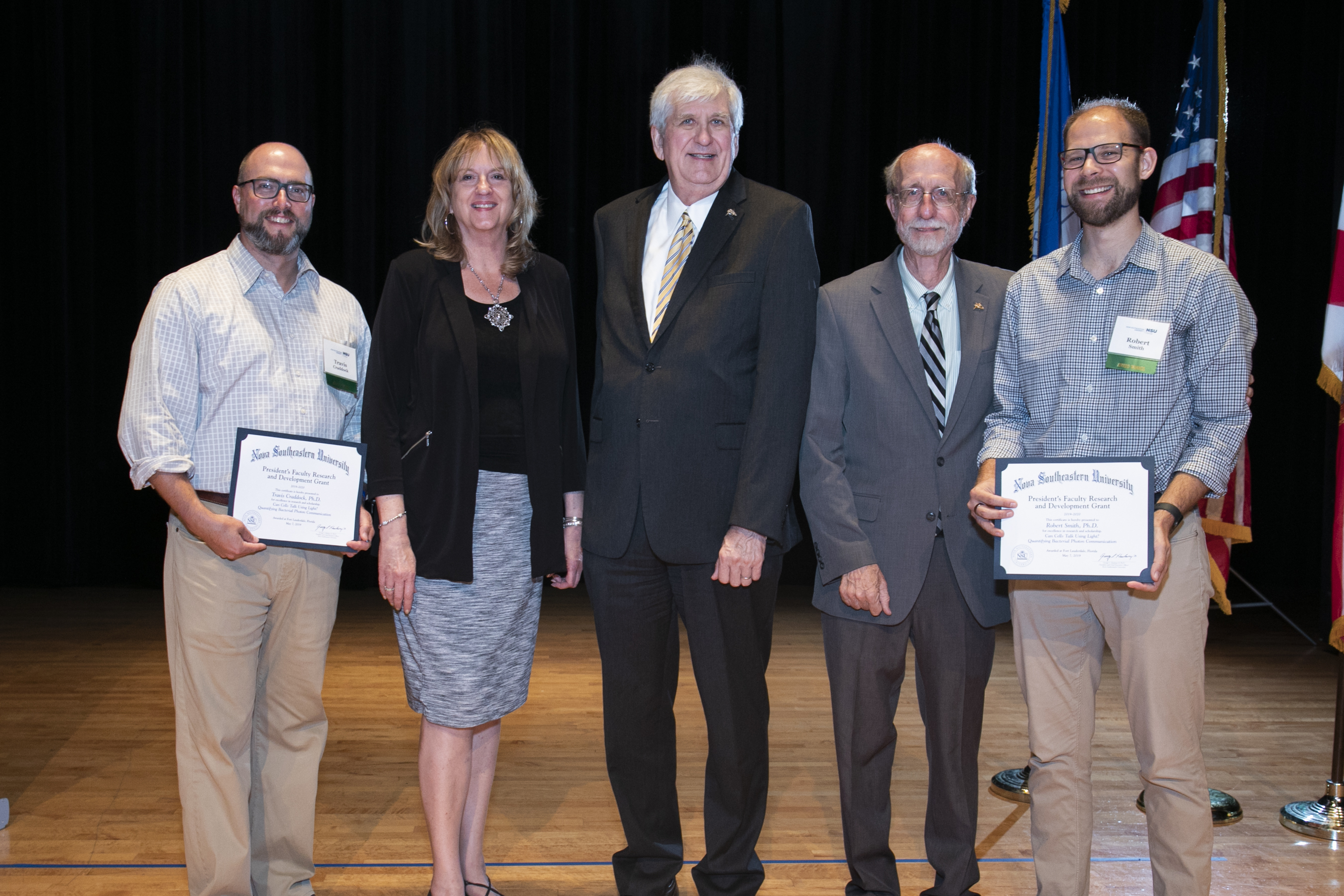Can Cells Talk Using Light? Quantifying Bacterial Photon Communication
Grant Winners
- Travis Craddock, Ph.D. – College of Psychology
- Robert Smith, Ph.D. – Halmos College of Oceanography and Natural Sciences
- Kerollos Ibrahim – Halmos College of Oceanography and Natural Sciences
- Jacob Hardy – College of Psychology
- Dr. Robert Alfano – City College of New York
Deans
- Karen Grosby, Ed.D. – College of Psychology
- Richard Dodge, Ph.D. – Halmos College of Oceanography and Natural Sciences
Abstract
 Cell-to-cell communication coordinates cellular activity and is therefore fundamental to the functioning of biological systems, including bacteria, and tissues of the human body, such as the brain. Cell-to-cell communication can occur using different mechanisms including direct cell-to-cell contact, release of small molecules, or electrical signals. These mechanisms are well established. For example, in bacteria, cell-to-cell communication regulates the expression of virulence factors and biofilm formation, both of which are important in infectious disease. Thus, cell- to-cell communication is widely regarded as being critical in regulating the growth of bacteria. Interestingly, there is a large number of recent experimental reports that describes signaling between physically separated cell cultures proposed to be mediated by light or other electromagnetic radiation. Our understanding of non-chemical, non-electrical forms of electromagnetic cellular communication, with the exception of very local physiological events (i.e. voltage-gated ion channels), is at a rudimentary level at best. Accordingly, the major aim of the proposed research is to initiate the study of cell-cell communication via light in bacteria. Within the scope of this grant, we propose two aims. 1) To initiate the detection, quantification and gene-level effects of light emitted from bacteria and 2) initiate the development of a mechanism of light production, and its effects on growth, using a mathematical model. Understanding how and when signaling via light occurs in bacteria will have a profound effect on our understanding of cell-to-cell communication, and in biology in general, and has direct applications in the medical field. It may also have extensions into neuroscience. The expertise of Dr. Travis Craddock (modeling of light-matter interactions in the biological sciences), and of Dr. Robert Smith (understanding cell-cell communication) will be leveraged to conduct a systematic pilot study to examine cell signaling through light in bacteria. Additionally, consultation from Dr. Robert Alfano, Distinguished Professor of Physics and Engineering at City College of New York, and world-renowned expert in photonics, will guide Drs. Craddock and Smith in the construction of a device to measure bacterial light emission. Students will play a central be assisting in the performance of both modeling and experimental aspects of the work. The preliminary data developed from this proposal will be used to develop and submit proposals to
Cell-to-cell communication coordinates cellular activity and is therefore fundamental to the functioning of biological systems, including bacteria, and tissues of the human body, such as the brain. Cell-to-cell communication can occur using different mechanisms including direct cell-to-cell contact, release of small molecules, or electrical signals. These mechanisms are well established. For example, in bacteria, cell-to-cell communication regulates the expression of virulence factors and biofilm formation, both of which are important in infectious disease. Thus, cell- to-cell communication is widely regarded as being critical in regulating the growth of bacteria. Interestingly, there is a large number of recent experimental reports that describes signaling between physically separated cell cultures proposed to be mediated by light or other electromagnetic radiation. Our understanding of non-chemical, non-electrical forms of electromagnetic cellular communication, with the exception of very local physiological events (i.e. voltage-gated ion channels), is at a rudimentary level at best. Accordingly, the major aim of the proposed research is to initiate the study of cell-cell communication via light in bacteria. Within the scope of this grant, we propose two aims. 1) To initiate the detection, quantification and gene-level effects of light emitted from bacteria and 2) initiate the development of a mechanism of light production, and its effects on growth, using a mathematical model. Understanding how and when signaling via light occurs in bacteria will have a profound effect on our understanding of cell-to-cell communication, and in biology in general, and has direct applications in the medical field. It may also have extensions into neuroscience. The expertise of Dr. Travis Craddock (modeling of light-matter interactions in the biological sciences), and of Dr. Robert Smith (understanding cell-cell communication) will be leveraged to conduct a systematic pilot study to examine cell signaling through light in bacteria. Additionally, consultation from Dr. Robert Alfano, Distinguished Professor of Physics and Engineering at City College of New York, and world-renowned expert in photonics, will guide Drs. Craddock and Smith in the construction of a device to measure bacterial light emission. Students will play a central be assisting in the performance of both modeling and experimental aspects of the work. The preliminary data developed from this proposal will be used to develop and submit proposals to several federal granting agencies.